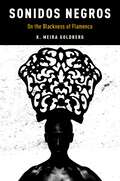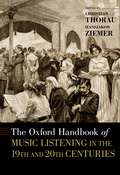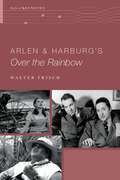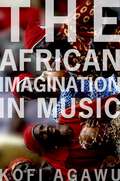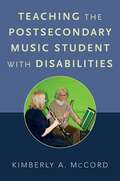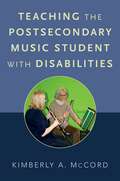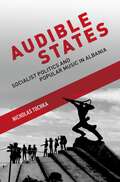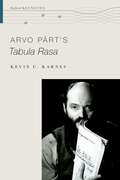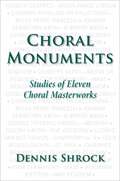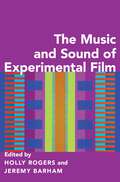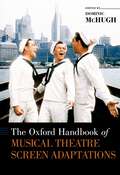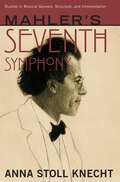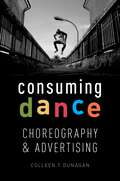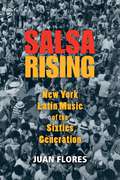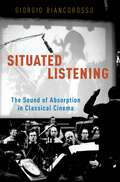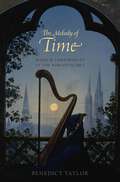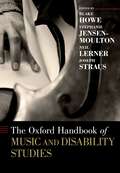- Table View
- List View
Sonidos Negros: On the Blackness of Flamenco (Currents in Latin American and Iberian Music)
by K. Meira GoldbergHow is the politics of Blackness figured in the flamenco dancing body? What does flamenco dance tell us about the construction of race in the Atlantic world? Sonidos Negros traces how, in the span between 1492 and 1933, the vanquished Moor became Black, and how this figure, enacted in terms of a minstrelized Gitano, paradoxically came to represent Spain itself. The imagined Gypsy about which flamenco imagery turns dances on a knife's edge delineating Christian and non-Christian, White and Black worlds. This figure's subversive teetering undermines Spain's symbolic linkage of religion with race, a prime weapon of conquest. Flamenco's Sonidos Negros live in this precarious balance, amid the purposeful confusion and ruckus cloaking embodied resistance, the lament for what has been lost, and the values and aspirations of those rendered imperceptible by enslavement and colonization.
SONIDOS NEGROS ON BLACKN OF FLAM CILAM C: On the Blackness of Flamenco (Currents in Latin American and Iberian Music)
by K. Meira GoldbergHow is the politics of Blackness figured in the flamenco dancing body? What does flamenco dance tell us about the construction of race in the Atlantic world? Sonidos Negros traces how, in the span between 1492 and 1933, the vanquished Moor became Black, and how this figure, enacted in terms of a minstrelized Gitano, paradoxically came to represent Spain itself. The imagined Gypsy about which flamenco imagery turns dances on a knife's edge delineating Christian and non-Christian, White and Black worlds. This figure's subversive teetering undermines Spain's symbolic linkage of religion with race, a prime weapon of conquest. Flamenco's Sonidos Negros live in this precarious balance, amid the purposeful confusion and ruckus cloaking embodied resistance, the lament for what has been lost, and the values and aspirations of those rendered imperceptible by enslavement and colonization.
The Oxford Handbook of Music Listening in the 19th and 20th Centuries (Oxford Handbooks)
An idealized image of European concert-goers has long prevailed in historical overviews of the nineteenth and twentieth centuries. This act of listening was considered to be an invisible and amorphous phenomenon, a naturally given mode of perception. This narrative influenced the conditions of listening from the selection of repertoire to the construction of concert halls and programmes. However, as listening moved from the concert hall to the opera house, street music, and jazz venues, new and visceral listening traditions evolved. In turn, the art of listening was shaped by phenomena of the modern era including media innovation and commercialization. This Handbook asks whether, how, and why practices of music listening changed as the audience moved from pleasure gardens and concert venues in the eighteenth century to living rooms in the twentieth century, and mobile devices in the twenty-first. Through these questions, chapters enable a differently conceived history of listening and offer an agenda for future research.
The Oxford Handbook of Music Listening in the 19th and 20th Centuries (Oxford Handbooks)
by Christian Thorau and Hansjakob ZiemerAn idealized image of European concert-goers has long prevailed in historical overviews of the nineteenth and twentieth centuries. This act of listening was considered to be an invisible and amorphous phenomenon, a naturally given mode of perception. This narrative influenced the conditions of listening from the selection of repertoire to the construction of concert halls and programmes. However, as listening moved from the concert hall to the opera house, street music, and jazz venues, new and visceral listening traditions evolved. In turn, the art of listening was shaped by phenomena of the modern era including media innovation and commercialization. This Handbook asks whether, how, and why practices of music listening changed as the audience moved from pleasure gardens and concert venues in the eighteenth century to living rooms in the twentieth century, and mobile devices in the twenty-first. Through these questions, chapters enable a differently conceived history of listening and offer an agenda for future research.
Arlen and Harburg's Over the Rainbow (Oxford Keynotes)
by Walter Frisch"Over the Rainbow" exploded into worldwide fame upon its performance by Judy Garland in the MGM film musical The Wizard of Oz (1939). Voted the greatest song of the twentieth century in a 2000 survey, it is a masterful, delicate balance of sophistication and child-like simplicity in which composer Harold Arlen and lyricist E. Y. "Yip" Harburg poignantly captured the hope and anxiety harbored by Dorothy's character. In Arlen and Harburg's Over the Rainbow, author Walter Frisch traces the history of this song from its inception during the development of The Wizard of Oz's screenplay, to its various reinterpretations over the course of the twentieth century. Through analysis of the song's music and lyrics, this Oxford Keynotes volume provides a close reading of the piece while examining the evolution of its meaning as it traversed widely varying cultural contexts. From its adoption as a jazz standard by generations of pianists, to its contribution to Judy Garland's role as a gay icon, to its reemergence as a chart-topping recording by Hawaiian singer Israel Kamakawiwo'ole, "Over the Rainbow" continues to engage audiences and performers alike in surprising ways. Featuring a companion website with audio and video supplements, this book leaves no path unexplored as it succeeds in capturing the extent of this song's impact on the world.
Arlen and Harburg's Over the Rainbow (Oxford Keynotes)
by Walter Frisch"Over the Rainbow" exploded into worldwide fame upon its performance by Judy Garland in the MGM film musical The Wizard of Oz (1939). Voted the greatest song of the twentieth century in a 2000 survey, it is a masterful, delicate balance of sophistication and child-like simplicity in which composer Harold Arlen and lyricist E. Y. "Yip" Harburg poignantly captured the hope and anxiety harbored by Dorothy's character. In Arlen and Harburg's Over the Rainbow, author Walter Frisch traces the history of this song from its inception during the development of The Wizard of Oz's screenplay, to its various reinterpretations over the course of the twentieth century. Through analysis of the song's music and lyrics, this Oxford Keynotes volume provides a close reading of the piece while examining the evolution of its meaning as it traversed widely varying cultural contexts. From its adoption as a jazz standard by generations of pianists, to its contribution to Judy Garland's role as a gay icon, to its reemergence as a chart-topping recording by Hawaiian singer Israel Kamakawiwo'ole, "Over the Rainbow" continues to engage audiences and performers alike in surprising ways. Featuring a companion website with audio and video supplements, this book leaves no path unexplored as it succeeds in capturing the extent of this song's impact on the world.
AFRICAN IMAGINATION IN MUSIC C
by Kofi AgawuThe world of Sub-Saharan African music is immensely rich and diverse, containing a plethora of repertoires and traditions. In The African Imagination in Music, renowned music scholar Kofi Agawu offers an introduction to the major dimensions of this music and the values upon which it rests. Agawu leads his readers through an exploration of the traditions, structural elements, instruments, and performative techniques that characterize the music. In sections that focus upon rhythm, melody, form, and harmony, the essential parts of African music come into relief. While traditional music, the backbone of Africa's musical thinking, receives the most attention, Agawu also supplies insights into popular and art music in order to demonstrate the breadth of the African musical imagination. Close readings of a variety of songs, including an Ewe dirge, an Aka children's song, and Fela's 'Suffering and Smiling' supplement the broader discussion. The African Imagination in Music foregrounds a hitherto under-reported legacy of recordings and insists on the necessity of experiencing music as sound in order to appreciate and understand it fully. Accordingly, a Companion Website features important examples of the music discussed in detail in the book. Accessibly and engagingly written for a general audience, The African Imagination in Music is poised to renew interest in Black African music and to engender discussion of its creative underpinnings by Africanists, ethnomusicologists, music theorists and musicologists.
Teaching the Postsecondary Music Student with Disabilities
by Kimberly A. McCordTeaching the Postsecondary Music Student with Disabilities provides valuable information and practical strategies for teaching the college music student. With rising numbers of students with disabilities in university music schools, professors are being asked to accommodate students in their studios, classes, and ensembles. Most professors have little training or experience in teaching students with disabilities. This book provides a resource for creating an inclusive music education for students who audition and enter music school. Teaching the Postsecondary Music Student with Disabilities covers all of the topics that all readers need to know including law, assistive technology, high-incidence and low-incidence disabilities, providing specific details on the disability and how it impacts the learning of the music student.
TEACHING POSTSEC MUS STUD WITH DISABIL C
by Kimberly A. McCordTeaching the Postsecondary Music Student with Disabilities provides valuable information and practical strategies for teaching the college music student. With rising numbers of students with disabilities in university music schools, professors are being asked to accommodate students in their studios, classes, and ensembles. Most professors have little training or experience in teaching students with disabilities. This book provides a resource for creating an inclusive music education for students who audition and enter music school. Teaching the Postsecondary Music Student with Disabilities covers all of the topics that all readers need to know including law, assistive technology, high-incidence and low-incidence disabilities, providing specific details on the disability and how it impacts the learning of the music student.
Audible States: Socialist Politics and Popular Music in Albania
by Nicholas TochkaDuring the Cold War, state-sponsored musical performances were central to the diplomatic agendas of the United States and the Soviet Union. But states on the periphery of the conflict also used state-funded performances to articulate their positions in the polarized global network. In Albania in particular, the postwar government invested heavily in public performances at home, effectively creating a new genre of popular music: the wildly popular light music. In Audible States: Socialist Politics and Popular Music in Albania, author Nicholas Tochka traces an aural history of Albania's government through a close examination of the development and reception of light music at Radio-Television Albania's Festival of Song. Drawing on a wide range of archival resources and over forty interviews with composers, lyricists, singers, and bureaucrats, Tochka describes how popular music became integral to governmental projects to improve society--and a major concern for both state-socialist and postsocialist regimes between 1945 and the present. Tochka's narrative begins in the immediate postwar period, arguing that state officials saw light music as a means to cultivate a modern population under socialism. As the Cold War ended, postsocialist officials turned again to light music, now hoping that these musicians could help shape Albania into a capitalist, "European" state. Interweaving archival research with ethnographic interviews, Audible States demonstrates that modern political orders do not simply render social life visible, but also audible. Incorporating insights from ethnomusicology, governmentality studies, and post-socialist studies, Audible States presents an original perspective on music and government that reveals the fluid, pervasive, but ultimately limited nature of state power in the modern world. A remarkably researched and engagingly written study, Audible States is a foundational text in the growing literature on popular music and culture in post-socialist Europe and will be of great interest for readers interested in popular music, sound studies, and the politics of the Cold War.
Arvo Pärt's Tabula Rasa (Oxford Keynotes)
by Kevin C. KarnesOne of today's most widely acclaimed composers, Arvo Pärt broke into the soundscape of the Cold War West with Tabula Rasa in 1977, a work that introduced his signature tintinnabuli style to listeners throughout the world. In the first book dedicated to this pathbreaking composition, author Kevin C. Karnes tells the story of Tabula Rasa as one of Pärt and of Europe itself, traced over the course of a quarter-century that saw momentous transitions in European culture and politics, history and memory. Beginning at the site of the work's creation in the Estonian SSR, and drawing extensively upon a range of previously unexamined archival materials, Karnes recounts Pärt's discovery of tintinnabuli amidst his experiments with the music of the Western and Soviet avant-gardes. He examines Tabula Rasa in relation to modernist conceptions of musical structure, the ascetic practice of Orthodox Christianity, postwar experiences of electronic music, and the polystylistic approaches to composition that have become emblematic of the Soviet 1970s. Tracing the export of Tabula Rasa to the West and Pärt's emigration in 1980, the book reveals intersections of critical commentary with visions of the "end of history" that attended the collapse of European communism to suggest that it was in this confluence of listening, discovery, and geopolitical reordering that enduring lines of conversation about Pärt and his music took shape.
ARVO PARTS TABULA RASA OKS C (Oxford Keynotes)
by Kevin C. KarnesOne of today's most widely acclaimed composers, Arvo Pärt broke into the soundscape of the Cold War West with Tabula Rasa in 1977, a work that introduced his signature tintinnabuli style to listeners throughout the world. In the first book dedicated to this pathbreaking composition, author Kevin C. Karnes tells the story of Tabula Rasa as one of Pärt and of Europe itself, traced over the course of a quarter-century that saw momentous transitions in European culture and politics, history and memory. Beginning at the site of the work's creation in the Estonian SSR, and drawing extensively upon a range of previously unexamined archival materials, Karnes recounts Pärt's discovery of tintinnabuli amidst his experiments with the music of the Western and Soviet avant-gardes. He examines Tabula Rasa in relation to modernist conceptions of musical structure, the ascetic practice of Orthodox Christianity, postwar experiences of electronic music, and the polystylistic approaches to composition that have become emblematic of the Soviet 1970s. Tracing the export of Tabula Rasa to the West and Pärt's emigration in 1980, the book reveals intersections of critical commentary with visions of the "end of history" that attended the collapse of European communism to suggest that it was in this confluence of listening, discovery, and geopolitical reordering that enduring lines of conversation about Pärt and his music took shape.
Choral Monuments: Studies of Eleven Choral Masterworks
by Dennis ShrockChoral Monuments provides extensive material about eleven epoch-making choral masterworks that span the history of Western culture. Included are: Missa Pange lingua (Josquin Desprez); Missa Papae Marcelli (G. P. da Palestrina); B Minor Mass (J. S. Bach); Messiah (G. F. Handel); The Creation (Joseph Haydn); Symphony #9 (Ludwig van Beethoven); St. Paul (Felix Mendelssohn); Ein deutsches Requiem (Johannes Brahms); Messa da Requiem (Giuseppe Verdi); Mass (Igor Stravinsky); and War Requiem (Benjamin Britten). The works are presented in separate chapters, with each chapter divided into three basic sections-history, analysis, and performance practice. Discussions of history are focused on relevancies-the genesis of the designated work in reference to the composer's total choral output, the work's place within the musical environment and social climate of its time, and essential features of the work that make it noteworthy. In addition, the compositional history addresses three other factors: the work's public reception and critical response, both at the time of its composition and in ensuing years; the history of score publications, detailing the various differences between editions; and the texts of the composition. The material regarding textual treatment, which often includes the complete texts of the works being discussed, concentrates on primary concerns of the text's usage; also included in the discussion are noteworthy aspects of texts separate from the music as well as biographical details of librettists and poets, if appropriate. The analysis section of each chapter outlines and describes musical forms and other types of compositional organization, including parody technique, mirror structures, and motto repetitions, as well as salient compositional characteristics that directly relate and contribute to the work's artistic stature. Numerous charts and musical examples illustrate the discussions. The discussion of performance practices includes primary source quotations about a wide range of topics, from performing forces, tempo, and phrasing of each work to specific issues such as tactus, text underlay, musica ficta, metric accentuation, and ornamentation.
Choral Monuments: Studies of Eleven Choral Masterworks
by Dennis ShrockChoral Monuments provides extensive material about eleven epoch-making choral masterworks that span the history of Western culture. Included are: Missa Pange lingua (Josquin Desprez); Missa Papae Marcelli (G. P. da Palestrina); B Minor Mass (J. S. Bach); Messiah (G. F. Handel); The Creation (Joseph Haydn); Symphony #9 (Ludwig van Beethoven); St. Paul (Felix Mendelssohn); Ein deutsches Requiem (Johannes Brahms); Messa da Requiem (Giuseppe Verdi); Mass (Igor Stravinsky); and War Requiem (Benjamin Britten). The works are presented in separate chapters, with each chapter divided into three basic sections-history, analysis, and performance practice. Discussions of history are focused on relevancies-the genesis of the designated work in reference to the composer's total choral output, the work's place within the musical environment and social climate of its time, and essential features of the work that make it noteworthy. In addition, the compositional history addresses three other factors: the work's public reception and critical response, both at the time of its composition and in ensuing years; the history of score publications, detailing the various differences between editions; and the texts of the composition. The material regarding textual treatment, which often includes the complete texts of the works being discussed, concentrates on primary concerns of the text's usage; also included in the discussion are noteworthy aspects of texts separate from the music as well as biographical details of librettists and poets, if appropriate. The analysis section of each chapter outlines and describes musical forms and other types of compositional organization, including parody technique, mirror structures, and motto repetitions, as well as salient compositional characteristics that directly relate and contribute to the work's artistic stature. Numerous charts and musical examples illustrate the discussions. The discussion of performance practices includes primary source quotations about a wide range of topics, from performing forces, tempo, and phrasing of each work to specific issues such as tactus, text underlay, musica ficta, metric accentuation, and ornamentation.
The Music and Sound of Experimental Film
This book explores music/sound-image relationships in non-mainstream screen repertoire from the earliest examples of experimental audiovisuality to the most recent forms of expanded and digital technology. It challenges presumptions of visual primacy in experimental cinema and rethinks screen music discourse in light of the aesthetics of non-commercial imperatives. Several themes run through the book, connecting with and significantly enlarging upon current critical discourse surrounding realism and audibility in the fiction film, the role of music in mainstream cinema, and the audiovisual strategies of experimental film. The contributors investigate repertoires and artists from Europe and the USA through the critical lenses of synchronicity and animated sound, interrelations of experimentation in image and sound, audiovisual synchresis and dissonance, experimental soundscape traditions, found-footage film, re-mediation of pre-existent music and sound, popular and queer sound cultures, and a diversity of radical technological, aesthetic, tropes in film media traversing the work of early pioneers such as Walther Ruttmann and Len Lye, through the mid-century innovations of Norman McLaren, Stan Brakhage, Lis Rhodes, Kenneth Anger, Andy Warhol, and studio collectives in Poland, to latter-day experimentalists John Smith and Bill Morrison, as well as the contemporary practices of Vjing.
MUSIC & SOUND OF EXPERIMENTAL FILM C
by Holly Rogers and Jeremy BarhamThis book explores music/sound-image relationships in non-mainstream screen repertoire from the earliest examples of experimental audiovisuality to the most recent forms of expanded and digital technology. It challenges presumptions of visual primacy in experimental cinema and rethinks screen music discourse in light of the aesthetics of non-commercial imperatives. Several themes run through the book, connecting with and significantly enlarging upon current critical discourse surrounding realism and audibility in the fiction film, the role of music in mainstream cinema, and the audiovisual strategies of experimental film. The contributors investigate repertoires and artists from Europe and the USA through the critical lenses of synchronicity and animated sound, interrelations of experimentation in image and sound, audiovisual synchresis and dissonance, experimental soundscape traditions, found-footage film, re-mediation of pre-existent music and sound, popular and queer sound cultures, and a diversity of radical technological, aesthetic, tropes in film media traversing the work of early pioneers such as Walther Ruttmann and Len Lye, through the mid-century innovations of Norman McLaren, Stan Brakhage, Lis Rhodes, Kenneth Anger, Andy Warhol, and studio collectives in Poland, to latter-day experimentalists John Smith and Bill Morrison, as well as the contemporary practices of Vjing.
The Oxford Handbook of Musical Theatre Screen Adaptations (Oxford Handbooks)
Hollywood's conversion to sound in the 1920s created an early peak in the film musical, following the immense success of The Jazz Singer. The opportunity to synchronize moving pictures with a soundtrack suited the musical in particular, since the heightened experience of song and dance drew attention to the novelty of the technological development. Until the near-collapse of the genre in the 1960s, the film musical enjoyed around thirty years of development, as landmarks such as The Wizard of Oz, Meet Me in St Louis, Singin' in the Rain, and Gigi showed the exciting possibilities of putting musicals on the silver screen. The Oxford Handbook of Musical Theatre Screen Adaptations traces how the genre of the stage-to-screen musical has evolved, starting with screen adaptations of operettas such as The Desert Song and Rio Rita, and looks at how the Hollywood studios in the 1930s exploited the publication of sheet music as part of their income. Numerous chapters examine specific screen adaptations in depth, including not only favorites such as Annie and Kiss Me, Kate but also some of the lesser-known titles like Li'l Abner and Roberta and problematic adaptations such as Carousel and Paint Your Wagon. Together, the chapters incite lively debates about the process of adapting Broadway for the big screen and provide models for future studies.
Mahler's Seventh Symphony (Studies in Musical Genesis, Structure, and Interpretation)
by Anna Stoll KnechtGustav Mahler's Seventh Symphony stands out as one of the most provocative symphonic statements of the early twentieth century. Throughout its performance history, it has often been heard as "existing in the shadow" of the Sixth Symphony or as "too reminiscent" of Richard Wagner's opera Die Meistersinger von Nürnberg. Anna Stoll Knecht's Mahler's Seventh Symphony offers a new interpretation of the Seventh based on a detailed study of Mahler's compositional materials and a close reading of the finished work. With a focus on sketches previously considered as "discarded," Stoll Knecht exposes unexpected connections between the Seventh and both the Sixth and Meistersinger, confirming that Mahler's compositional project was firmly grounded in a dialogue with works from the past. This referential aspect acts as an important interpretive key to the work, enabling the first thorough analysis of the sketches and drafts for the Seventh, and shedding light on its complex compositional history. Considering each movement of the symphony through a double perspective, genetic and analytic, Stoll Knecht demonstrates how sketch studies and analytical approaches can interact with each other. Mahler's Seventh Symphony exposes new facets of Mahler's musical humor and leads us to rethink much-debated issues concerning the composer's cultural identity, revealing the Seventh's pivotal role within his output.
Consuming Dance: Choreography and Advertising
by Colleen T. DunaganDance in TV advertisements has long been familiar to Americans as a silhouette dancing against a colored screen, exhibiting moves from air guitar to breakdance tricks, all in service of selling the latest Apple product. But as author Colleen T. Dunagan shows in Consuming Dance, the advertising industry used dance to market items long before iPods. In this book, Dunagan lays out a comprehensive history and analysis of dance commercials to demonstrate the ways in which the form articulates with, informs, and reflects U.S. culture. In doing so, she examines dance commercials as cultural products, looking at the ways in which dance engages with television, film, and advertising in the production of cultural meaning. Throughout the book, Dunagan interweaves semiotics, choreographic analysis, cultural studies, and critical theory in an examination of contemporary dance commercials while placing the analysis within a historical context. She draws upon connections between individual dance-commercials and the discursive and production histories to provide a thorough look into brand identity and advertising's role in constructing social identities.
CONSUMING DANCE C: Choreography and Advertising
by Colleen T. DunaganDance in TV advertisements has long been familiar to Americans as a silhouette dancing against a colored screen, exhibiting moves from air guitar to breakdance tricks, all in service of selling the latest Apple product. But as author Colleen T. Dunagan shows in Consuming Dance, the advertising industry used dance to market items long before iPods. In this book, Dunagan lays out a comprehensive history and analysis of dance commercials to demonstrate the ways in which the form articulates with, informs, and reflects U.S. culture. In doing so, she examines dance commercials as cultural products, looking at the ways in which dance engages with television, film, and advertising in the production of cultural meaning. Throughout the book, Dunagan interweaves semiotics, choreographic analysis, cultural studies, and critical theory in an examination of contemporary dance commercials while placing the analysis within a historical context. She draws upon connections between individual dance-commercials and the discursive and production histories to provide a thorough look into brand identity and advertising's role in constructing social identities.
Salsa Rising: New York Latin Music of the Sixties Generation
by Juan FloresIn the 1920s and 30s, musicians from Latin America and the Caribbean were flocking to New York, lured by the burgeoning recording studios and lucrative entertainment venues. In the late 1940s and 50s, the big-band mambo dance scene at the famed Palladium Ballroom was the stuff of legend, while modern-day music history was being made as the masters of Afro-Cuban and jazz idiom conspired to create Cubop, the first incarnation of Latin jazz. Then, in the 1960s, as the Latino population came to exceed a million strong, a new generation of New York Latinos, mostly Puerto Ricans born and raised in the city, went on to create the music that came to be called salsa, which continues to enjoy avid popularity around the world. And now, the children of the mambo and salsa generation are contributing to the making of hip hop and reviving ancestral Afro-Caribbean forms like Cuban rumba, Puerto Rican bomba, and Dominican palo. Salsa Rising provides the first full-length historical account of Latin Music in this city guided by close critical attention to issues of tradition and experimentation, authenticity and dilution, and the often clashing roles of cultural communities and the commercial recording industry in the shaping of musical practices and tastes. It is a history not only of the music, the changing styles and practices, the innovators, venues and songs, but also of the music as part of the larger social history, ranging from immigration and urban history, to the formation of communities, to issues of colonialism, race and class as they bear on and are revealed by the trajectory of the music. Author Juan Flores brings a wide range of people in the New York Latin music field into his work, including musicians, producers, arrangers, collectors, journalists, and lay and academic scholars, enriching Salsa Rising with a unique level of engagement with and interest in Latin American communities and musicians themselves.
Situated Listening: The Sound of Absorption in Classical Cinema
by Giorgio BiancorossoScreenwriters and film directors have long been fascinated by the challenges of representing the listening experience on screen. While music has played a central role in film narrative since the conception of moving pictures, the representation of music listening has remained a special occurrence. In Situated Listening: The Sound of Absorption in Classical Cinema, author Giorgio Biancorosso argues for a redefinition of the music listener as represented in film. Rather than construct the listener as a reverential concertgoer, music analyst, or gallery dweller, this book instead shows how films offer a new way of thinking about listening as distributed experience, an activity made public and shareable across vast cultural spaces rather than an insular motion. It shows how cinema functions as not only a reservoir of established modes of listening, but also an agent in the development of new listening practices. As Biancorosso argues, many films have perpetuated a long-existing paradox of music as a means of silencing. Consider an aggressive score overlaying battle scenes or a romantic scene conveying unspoken intimacy. In the place of conversational exchange exists a veil of sound in the form of music, and Situated Listening explains why this function influences both the course of interpretation and empathy experienced by film spectators. By focusing on cinematic, physical, and emotional scenery surrounding a character, viewers can recognize aspects of their own lives, developing a deeper empathy for each fictional character through real and shared listening practices.
The Melody of Time: Music and Temporality in the Romantic Era
by Benedict TaylorFrom the Romantic era onwards, music has been seen as the most quintessentially temporal art, possessing a unique capacity to invoke the human experience of time. Through its play of themes and recurrence of events, music has the ability to stylise in multiple ways our temporal relation to the world, with far-reaching implications for modern conceptions of memory, subjectivity, personal and collective identity, and history. Time, as philosophers, scientists and writers have found throughout history, is notoriously hard to define. Yet music, seemingly bound up so intimately with the nature of time, might well be understood as disclosing aspects of human temporality unavailable to other modes of inquiry, and accordingly was frequently granted a privileged position in nineteenth-century thought. The Melody of Time examines the multiple ways in which music relates to, and may provide insight into, the problematics of human time. Each chapter explores a specific theme in the philosophy of time as expressed through music: the purported timelessness of Beethoven's late works or the nostalgic impulses of Schubert's music; the use of music by philosophers as a means to explicate the aporias of temporal existence or as a medium suggestive of the varying possible structures of time; and, a reflection of a particular culture's sense of historical progress or the expression of the intangible spirit behind the course of human history itself. Moving fluidly between cultural context and historical reception, competing philosophical theories of time and close reading of the repertoire, Benedict Taylor argues for the continued importance of engaging with music's temporality in understanding the significance of music within society and human experience. At once historical, analytical, critical, and ultimately hermeneutic, The Melody of Time provides both fresh insight into many familiar nineteenth-century pieces and a rich theoretical basis for future research.
The Oxford Handbook of Music and Disability Studies (Oxford Handbooks)
by Blake Howe, Stephanie Jensen-Moulton, Neil Lerner and Joseph StrausThe Oxford Handbook of Disability Studies represents a comprehensive state of current research for the field of Disability Studies and Music. The forty-two chapters in the book span a wide chronological and geographical range, from the biblical, the medieval, and the Elizabethan, through the canonical classics of the eighteenth and nineteenth centuries, up to modernist styles and contemporary musical theater and popular genres, with stops along the way in post-Civil War America, Ghana and the South Pacific, and many other interesting times and places. Disability is a broad, heterogeneous, and porous identity, and that diversity is reflected in the variety of bodily conditions under discussion here, including autism and intellectual disability, deafness, blindness, mobility impairment often coupled with bodily difference, and cognitive and intellectual impairments. Amid this diversity of time, place, style, medium, and topic, the chapters share two core commitments. First, they are united in their theoretical and methodological connection to Disability Studies, especially its central idea that disability is a social and cultural construction. Disability both shapes and is shaped by culture, including musical culture. Second, these essays individually and collectively make the case that disability is not something at the periphery of culture and music, but something central to our art and to our humanity.
